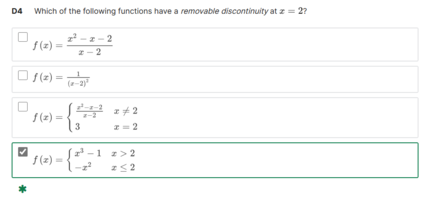Hi guys,
Can anyone help me solve this problem?
By definition, removable discontinuity is when the two-sided limit exists, but isn't equal to the function's value.
In the attached file, the last choice has two limits, the left limit is -4 when x = 2, the right limit is 7 when x = 2. so the two-sided limit doesn't exist. Therefore, this function should not have a removable discontinuity. Am I correct?
Thanks
Can anyone help me solve this problem?
By definition, removable discontinuity is when the two-sided limit exists, but isn't equal to the function's value.
In the attached file, the last choice has two limits, the left limit is -4 when x = 2, the right limit is 7 when x = 2. so the two-sided limit doesn't exist. Therefore, this function should not have a removable discontinuity. Am I correct?
Thanks

